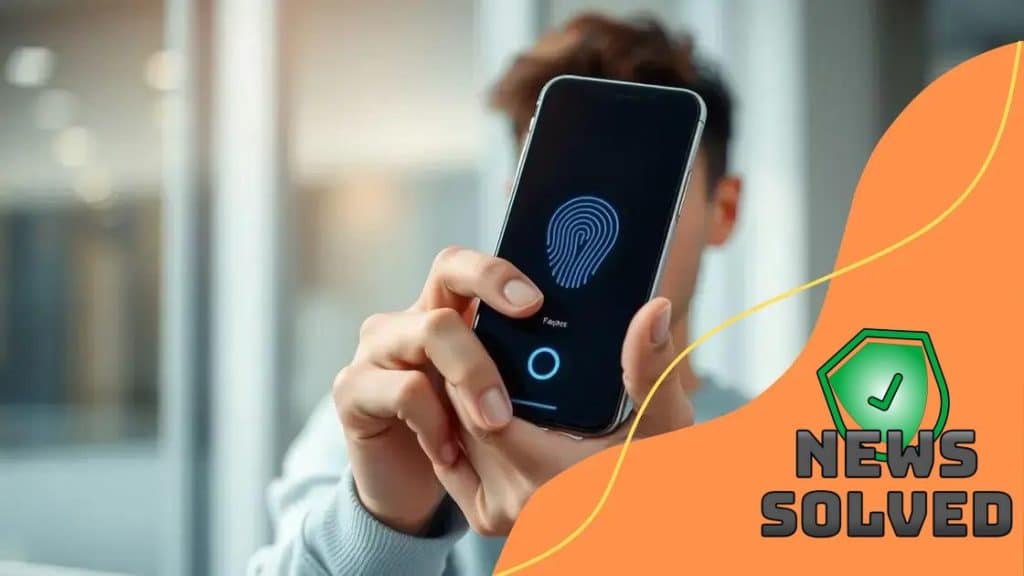The rise of biometric security in personal devices

Advertisements
The rise of biometric security in personal devices enhances data protection by using unique biological traits like fingerprints and facial recognition, ensuring faster access and reduced risk of unauthorized access.
The rise of biometric security in personal devices is changing the way we protect our personal information. Have you ever wondered how secure your data really is? This article dives into the fascinating world of biometric technology and its impact on our daily lives.
Advertisements
Understanding biometric security and its importance
Understanding biometric security is crucial in today’s world where personal devices are an integral part of our lives. This technology helps protect sensitive information by using unique characteristics of individuals, such as fingerprints or facial recognition.
Biometric security has gained popularity as a reliable way to authenticate users. It offers a blend of convenience and security that traditional methods struggle to match. As we rely more on personal devices, understanding this security method is essential.
Benefits of biometric security
One major advantage of biometric security is its difficulty to replicate. Unlike passwords or PINs, biometric traits are inherent and unique to each person. This makes it an effective barrier against unauthorized access.
Advertisements
- Enhanced protection for personal data.
- Faster access without the need to remember passwords.
- Reduced risk of identity theft.
Moreover, biometric security systems often integrate easily with other security measures, creating a layered approach to safety. It is important to note that while this technology provides significant benefits, it’s not without its challenges.
Challenges of implementing biometric security
Privacy concerns arise with the collection and storage of biometric data. Safeguarding this information becomes paramount, as breaches could lead to serious privacy violations.
- Potential data breaches expose sensitive information.
- Misuse of biometric data could lead to greater surveillance.
- Costs associated with implementing biometric systems can be high.
Furthermore, there is the risk of false negatives and positives in biometric recognition systems. This can lead to frustration for users. However, advancements in technology continue to improve the accuracy and reliability of these systems.
In conclusion, understanding biometric security is vital as we navigate a digital landscape that increasingly relies on these systems. As technology continues to evolve, the importance of biometric security in personal devices will only grow.
Different types of biometric methods used today
There are several different types of biometric methods used today to enhance security in personal devices. These methods utilize unique biological traits to verify identity, transforming the way we think about protection.
One common method is fingerprint recognition. This technology captures the unique patterns found on a person’s fingertip. It has become popular due to its speed and convenience, allowing users to unlock devices with just a touch.
Facial recognition
Facial recognition is another widely used method. It analyzes features such as the distance between the eyes and the shape of the jawline. This technology is increasingly present in smartphones and security systems. It allows for quick authentication without physical contact, making it user-friendly.
- Utilizes advanced algorithms to ensure accuracy.
- Can be used in various lighting conditions.
- Popular in law enforcement for surveillance purposes.
Another method is iris recognition, which examines the unique patterns in the colored part of the eye. This technology offers high precision and low likelihood of false matches. Its advantages make it a strong contender for secure environments.
Voice recognition
Voice recognition is also gaining popularity. By analyzing voice patterns and vocal characteristics, devices can recognize and authenticate users. This method is particularly useful in hands-free situations, offering both convenience and security.
- Can work in various environments with background noise.
- Enhances accessibility for users with disabilities.
- Is being integrated into virtual assistants and smart devices.
Additionally, there are signature recognition systems that analyze the way a person writes. This method can provide a secure way to authenticate users, especially in banking and financial transactions.
With various biometric methods available, the landscape of security continues to evolve. Each method has its strengths and may serve different purposes depending on the specific needs of users.
Benefits of biometric security in personal devices

The benefits of biometric security in personal devices are significant and transformative. By employing biological traits for authentication, these systems enhance both security and user experience.
One of the main advantages is increased security. Biometric characteristics, such as fingerprints and facial features, are unique to each individual. This uniqueness makes it extremely difficult for unauthorized users to gain access to sensitive information.
Convenience and speed
Another benefit is the convenience it provides. Users can unlock their devices quickly without needing to remember passwords or PINs. This rapid access fosters a smoother user experience, especially when time is crucial.
- Fast and easy authentication process.
- Hands-free unlocking options.
- Improves user satisfaction and device usability.
Moreover, biometric security systems are more difficult to bypass than traditional methods. Hackers often find it easier to steal passwords or PINs than to replicate a person’s biometric data. As technology advances, biometric methods are continuously being upgraded to enhance their security features further.
Reduction in identity theft
The use of biometric security also contributes to a reduction in identity theft. With traditional security methods, individuals are often vulnerable to phishing attacks that can expose their passwords. Biometric systems help protect against these forms of fraud.
- Minimizes the risk of stolen credentials.
- Enhances trust in digital transactions.
- Fosters safer online environments.
Additionally, integrating biometric security into personal devices can create a unified security framework. This layered approach combines biometrics with other security tactics for better overall protection, making personal data even more secure.
Overall, the advantages of biometric security in personal devices are evident. By providing higher security, improved user experience, and reduced risks of identity theft, biometric methods are becoming essential in the digital age.
Challenges faced in adopting biometric security
While there are many advantages to biometric security, there are also significant challenges faced in adopting biometric security. These challenges can impact users and organizations alike, influencing the overall effectiveness of these systems.
One major concern is the issue of privacy. Collecting and storing sensitive biometric data can lead to fears about how this information is used and protected. People worry about their personal data falling into the wrong hands, which can lead to misuse or surveillance.
Technological barriers
Another challenge is the technological barriers related to implementing biometric systems. Not all devices currently support biometric authentication, especially older models. This creates a divide, as users with the latest devices can benefit from enhanced security while others remain vulnerable.
- High costs of implementation for businesses.
- Incompatibility with existing systems.
- Need for regular updates and maintenance.
Additionally, there are concerns about the accuracy of biometric systems. False rejections can frustrate users, especially if they are unable to access their devices. Likewise, false positives can lead to unauthorized access, undermining the whole purpose of biometric security.
Legal and ethical issues
There are also legal and ethical issues to consider. Different countries have varying laws regarding biometric data protection. Organizations must navigate these complex legal landscapes to ensure compliance and avoid potential lawsuits.
- Lack of standard regulations across borders.
- Complexity of data ownership laws.
- Potential for misuse of collected data.
Lastly, user acceptance plays a crucial role in the challenge of adopting biometric security. Many users remain hesitant about using these systems, mainly due to a lack of understanding or trust in the technology. Education on the benefits and functioning of biometric systems can help improve acceptance.
Addressing these challenges is essential for the successful adoption of biometric security in personal devices. Understanding the risks and barriers can lead to better implementation strategies and user trust.
Future trends in biometric technology
The future trends in biometric technology are exciting and promise to shape how we protect our personal devices. As technology evolves, biometric systems are becoming more sophisticated, offering greater security and usability.
One major trend is the integration of artificial intelligence (AI) with biometric systems. AI can enhance the accuracy of recognition technologies by learning from user behavior over time. This means that devices can adapt to individual usage patterns, making authentication smoother and more reliable.
Improved accuracy
Future biometric systems are also focusing on improving accuracy. With advancements in algorithms, we can expect higher detection rates and fewer errors in recognizing users. Technologies like deep learning will be crucial in refining these processes.
- Enhanced facial recognition with 3D mapping.
- More precise fingerprint scanning techniques.
- Integration of multispectral imaging for better verification.
Another trend is the rise of multimodal biometric systems. Instead of relying on just one method, these systems combine multiple biometric traits, such as fingerprints and facial recognition. This increases security by providing layered protection, making it harder for unauthorized users to gain access.
Greater user convenience
As the demand for convenience grows, future biometric systems will focus on creating even more user-friendly experiences. This could involve hands-free options, such as eye recognition or voice authentication, allowing users to interact with their devices effortlessly.
- Voice recognition for smart home devices.
- Integration with wearable technology like smartwatches.
- Gesture recognition for seamless interactions.
Moreover, privacy and security concerns are driving the development of more secure storage methods for biometric data. Blockchain technology is emerging as a potential solution for securely storing and managing personal biometric information, ensuring that users retain control over their data.
Overall, the future of biometric technology shows promise in enhancing security while prioritizing user experience. These trends indicate a shift towards a more secure and user-friendly digital landscape.
FAQ – Frequently Asked Questions about Biometric Security in Personal Devices
What are biometric security systems?
Biometric security systems use unique biological traits, like fingerprints or facial recognition, to authenticate users and protect personal data.
How does biometric technology enhance security?
It offers a higher level of protection since biometric traits are unique to each individual, making it difficult for unauthorized users to gain access.
What are some challenges in adopting biometric security?
Challenges include privacy concerns, technological barriers, accuracy issues, and legal regulations that differ across regions.
What future trends can we expect in biometric technology?
Future trends include improved accuracy through AI, integration of multimodal systems, and enhanced user convenience for seamless interaction.





